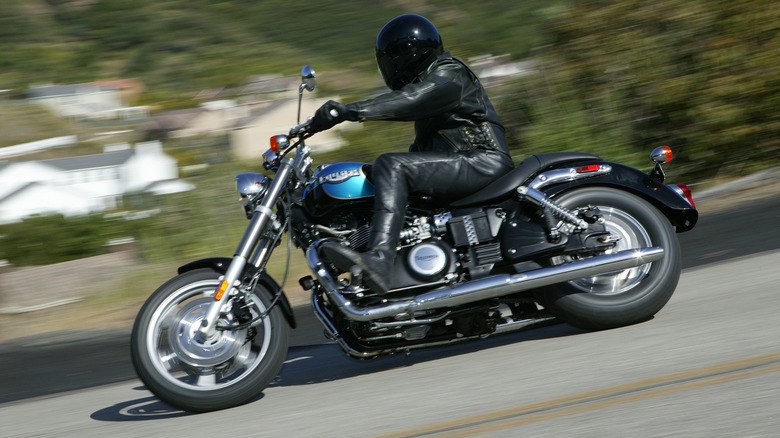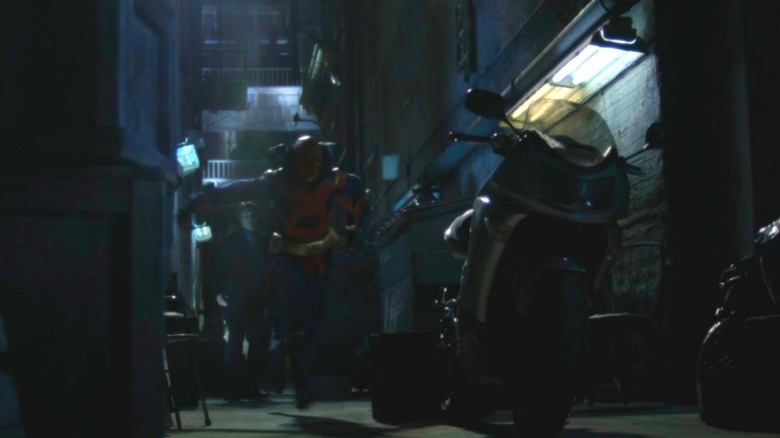5 Of The Most Iconic Appearances Of Kawasaki Motorcycles In Movies And TV
Motorcycles are no stranger to the silver screen. The aggressiveness, speed, and slick design of these modern mechanical marvels opens the floodgates to thrilling cinematic possibilities. However, while brands such as Harley-Davidson and Triumph have made plenty of prominent movie and TV appearances over the years, one that has received less attention is Kawasaki.
There's no denying the place that the style, performance, and historical significance that these iconic imports bring to the table. Since the 1960s, Kawasaki has changed the game in the motorcycle industry, from innovations in traction control and air cooling to making monumental production partnerships with the United States. The company has gone on to produce an array of distinctly stylish motorcycles suited for every purpose, including street, off-road, cross-country, racetrack, and everything in between.
While they may not have quite the number of starring pop culture appearances as other motorcycle brands, whenever a Kawasaki does make an appearance, you can bet it will make an impression. Along with their many notable moments in motorcycle history, these pop culture moments have made serious contributions to the popularity and ever-lasting iconography of Kawasaki's many mean machines.
Kill Bill: Vol. 1 - Kawasaki ZZR250
Quentin Tarantino has always had a knack for featuring iconic vehicles in his movies. From the diverse array of American classics in 1994's "Pulp Fiction" to the mean muscle cars of 2007's "Death Proof" to the '60s era luxury vehicles in 2019's "Once Upon a Time in Hollywood," it's safe to say that the two-time Oscar-winning filmmaker has a good eye for cinematic cars. However, his interests also extend to vehicles on two wheels, as can be seen in 2003's "Kill Bill: Vol. 1."
Towards the end of the first part of Tarantino's epic two-part revenge saga, Beatrix "The Bride" Kiddo, played by Uma Thurman, arrives in Tokyo on the hunt for the infamous yakuza boss O-Ren Ishii, played by Lucy Liu. To reach her destination, Kiddo takes a ride through the city on a machine as sleek and mean as she is, the Kawasaki ZZR250. The ZZR250 has gained a well-earned reputation as one of the best beginner sports bikes from the company. Starting production in the late 1980s, the ZZR250 was only redesigned on a handful of occasions, which can largely be attributed to its powerful engine and stellar brake technology that gave this bike unmatched agility and speed.
Even if it only shows up in this brief section, there's no denying the impression that the ZZR250 leaves. With Uma Thurman donning a yellow black-striped jumpsuit reminiscent of Bruce Lee's iconic wardrobe in 1978's "Game of Death," Tarantino and company gave their ZZR250 the same color scheme, creating a striking image that's hard to forget.
Top Gun - Kawasaki GPZ900R
Few who worked on 1986's "Top Gun" could have imagined the monster hit that the film would become among its release. With a worldwide box office gross of $357 million, it became the year's highest-grossing title, cementing Tom Cruise, high-flying fighter jets, and Kenny Loggins songs as cultural touchstones for years to come. But among the many moments from the film that became seared into the minds of audiences, an early scene seeing Cruise's Pete "Maverick" Mitchell zooming past a roaring fighter jet on a shiny new motorcycle to "Danger Zone" left an especially unique impact.
The Kawasaki GPZ900R had only been out for about two years prior to its appearance in "Top Gun." It had plenty to offer, with the ability to hit top speeds of 151 miles per hour (making it the first production motorcycle to exceed 150 mph) while still being able to perform well in urban settings thanks to its superior handling and stability. Initially, Kawasaki Motors marketing director Mike Vaughan had been hesitant to lend the "Top Gun" team any of their motorcycles, given past issues with other productions not returning their bikes and Cruise not yet being the world-famous star we know him as today. But thanks to Cruise and the producers' insistence, Vaughan relented and allowed them to rent out three GPZ900R Ninjas, and the rest is history.
Top Gun: Maverick - Kawasaki Ninja H2
Even if it came out over three decades later, 2022's "Top Gun: Maverick" made a sizable effort to capture the heart and spirit of its predecessor. But while it paid homage to many of the most memorable images and songs from the first film, it also made sure to carve out an identity, all by adding its own modern-day spin to these elements. This is evident through Maverick's newest hot rod, which respected the legacy of the original motorcycle while showing off Kawasaki's new toy.
The sequel would see Cruise run wild on a Kawasaki Ninja H2. Since hitting the roads in 2015, the HR2 became notable for its super-powered capabilities as a racing machine. The motorcycle's 998cc four-cylinder engine has the capability of producing more than 200 horsepower at 11,000 RPM, making it easy to see why Kawasaki would want it front and center in a new "Top Gun" movie.
The filmmakers went about getting the H2 in an interesting way. An Instagram video showing professional stunt rider Tom Britton revving up his 2015 H2 in his living room while playfully arguing with his wife went viral and caught the eye of Tom Cruise, who specifically wanted Britton's bike for the movie. However, while the production initially informed Britton in 2018 that they would need his bike for six months to a year, he wouldn't get his bike back until early 2023, which would see it receive numerous modifications. Thankfully, Britton was not upset and Kawasaki made up for the lost time by gifting him a 2020 H2 Carbon.
Project Power - 2008 Kawasaki Ninja 250R
"Project Power" became a surprise hit for Netflix when it released in the middle of 2020. The sci-fi crime drama starring Jamie Foxx, Joseph Gordon-Levitt, and Dominque Fishback would be viewed by 75 million households in its first month of release on the service and became one of the top-ranking streaming titles of that year. For a movie that exudes such a slick style like "Project Power," it's hard to imagine the team using any motorcycle other than a Kawasaki.
When Robin (Fishback) and Art (Foxx) track down a private demonstration of a drug called "Power", they notice one of the drug's investors parking his Kawasaki Ninja 250R in front of the building. Art's infiltration of the meeting turns chaotic, resulting in the death of all the investors and Art getting arrested by Detective Frank (Gordon-Levitt). Robin becomes distraught by this, but soon spots an employee of one of the bad guys driving away from the scene. Determined to find out where he's going, she steals the Ninja 250R and follows his car, which leads her to a mysterious shipping yard.
The Ninja 250R has been around for quite some time, debuting in 1986. Like some other Kawasaki racing motorcycles, the 250R would see some of its specs go down as the years went on to make it more accessible to mid-range riders. Some markets have replaced it with the Ninja 300.
Castle - Kawasaki Ninja 650R
If you're going to stage a speedy getaway, you'll need something with plenty of speed to get you moving. In that case, it's easy to see why a bad guy featured in a 2011 episode of the four-time Emmy-nominated crime comedy drama "Castle" would go for a Kawasaki. More specifically, a Kawasaki Ninja 650R.
In the second episode of Season 4, entitled "Heroes and Villains," Richard Castle (Nathan Fillion) and Kate Beckett (Stana Katic) are on the hunt for a mysterious killer who uses a sword as their weapon of choice. They later discover that the killer is taking on the persona of the fictional comic book anti-hero Lone Vengeance and eventually track down a suspect donning the character's costume running through an alleyway at night. The suspect is able to move too swiftly to be apprehended by the detectives, however, and makes a quick escape atop their Ninja 650R, although it later turns out that there's more to this case than meets the eye.
The 650R debuted in 2006. When initially released, the bike exerted 70 horsepower at a max revolutions per minute of 7,000 and 66 newton-meters of torque. It's gone through numerous changes over the years, with notable adjustments made to its bodywork, handlebars, clutch, and engine. The year following the episode's release would see Kawasaki remove the R in its name as a way of attracting use from more casual riders.





